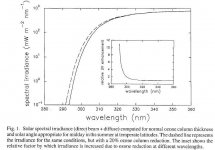knna
Member
nice post knna - great to have you here
so presumably the difference in UVB wavelength between altitude and temperate is doe to the atmosphere filtering out UVB below 290nm? thinner atmosphere at high altitude will filter out those wavelengths below 290 less efficiently??
VG
This graph shows how a ozone column reduction of 20% affect expected UVB irradiance. High elevation areas have such reduction of ozone column as well.
You can see how as all UVB irradiation is increased, it does little on most range, but below 300nm is when the difference is huge.
I believe, but this is pure speculation, that 288-292nm plays an esential role on the effect of UVB on plants. Maybe a reduced irradiance of just that narrow range could make the difference. But no way of testing it, AFAIK. Some day in the future maybe we have UVB LEDs with most emission between 285-300nm, but that would be the only way of testing and using it if result practical. Surely not avalaible on the near future (at not outrageous cost).






